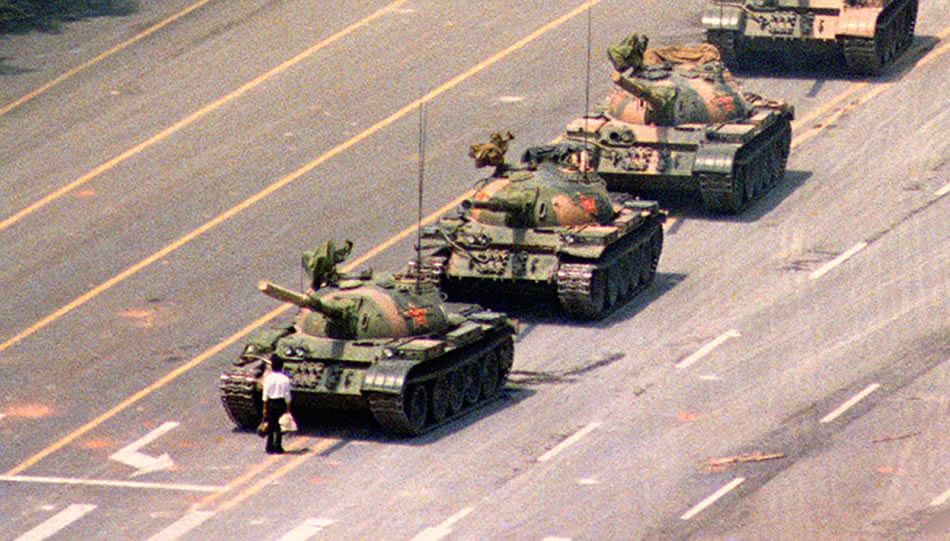On the 5th of June 1989, one of the most iconic shots of the last few decades was taken in Tiananmen Square, the heart of Beijing. In a white shirt and black trousers, a young student stood up in front of four tanks blocking their march to the enormous square of the Chinese capital. Initially, Jeff Widener, the American photographer who captured the scene, felt that this man entering his picture with two shopping bags was an element of disturbance for his reportage for Associated Press.
Overcoming his first impression, the photo reporter captured the snapshot with a 400mm lens from his Beijing Hotel room. The picture soon became a worldwide symbol of freedom and resistance not only in mainstream media and newspapers, but also in students’ bedroom posters and t-shirts, nourishing everyone’s dream of resistance.
As Widener revealed at a later time, this picture broke free to the world through another less known side story: owing to the high risk of arrest for censorship in China at that time, the film that captured the shot was smuggled out from the Beijing Hotel in the underwear of one of Widener’s collaborators before being released to the Western press – a compounded resistance effect.
To this day, the identity of the Tank Man remains unknown. All that we know about this young man is that he was in Tiananmen Square in the aftermath of violent repression undertaken by Chinese military forces in the attempt to stop student-led demonstrations advocating for democracy, better education, freedom of speech, and freedom of the press. After a month of protests, on the 4th of June 1989, the Chinese Authority decided to intervene with strong measures, generating the so-called Tiananmen Square Massacre. According to reporters and Western diplomats, on that day, the army was shooting over the crowd, causing the death of hundreds to thousands of protesters and as many as 10,000 arrests.
In different ways, 32 years later, young generations in many areas of the world – from East to West – are still enduring through their own resistance. Since the heroic gesture of the Tank Man, challenges have changed, taking different forms. Freedom of speech and censorship – taken for granted in the western world – nowadays is still a hot topic in some countries, and music and cultural events are the new targets of repression.
In 2018 in Cuba, for example, the enforcement of a law that allows the government to stop all the dissident artistic events generated a movement led by young rappers aimed to reconquer the lost freedom of expression: the San Isidro Movement.

In a country where the cultural isolation from the rest of the world is fueled by one of the least developed access to the internet and IT infrastructure of the world, young artists without social media and other forms of advertisement were able to create a nation-wide movement, which also aggregated the protest of part of academics and independent journalists of the Caribbean island.
This initiative of youth dissent is not the only one. The environmental crisis that dramatically evolved in the last decade has become the mission of many ecologic associations, NGOs, and international institutions (as discussed also on this blog here and here).
However, in 2018 a unconventional protest took place in Europe: a high school student, Greta Thunberg, initiated a climate-change movement that soon became a worldwide phenomenon. “In the three weeks leading up to the Swedish election, she sat outside Swedish Parliament every school day, demanding urgent action on the climate crisis. She was tired of society’s unwillingness to see the climate crisis for what it is: a crisis“ reports the website now dedicated to the cause. The propagation of the message ad the demonstrators’ mediatic impact was astonishing, considering that the initial group of students had no funding and no initial network, but only their mobile phones and social media accounts. Against all the odds, two years later that young high school girl arrived to discuss climate change in Davos at the World Economic Forum, sharing the stage with the most influential people on the planet.
The aforementioned initiatives are only two remarkable examples, proving that youth resistance is still alive even though manifested in different ways. Many silent battles are in place in daily life, such as the job hunt in a hyper-competitive market where fresh graduates struggle to find stable contracts, and the fight against the gender pay gap and sexual discrimination in the workplace.
It might be possible that we have been told by someone of prior generations “you’re not tough enough”; but all in all, I think the Tank Man would be proud of the way we are fighting those small and big battles.
Lavora con i numeri ma ama le parole. Le sue radici affondano nella Magna Grecia, ma dopo aver vissuto in 5 Nazioni su 2 continenti ha molti posti che può chiamare casa. Storyteller wannabe


